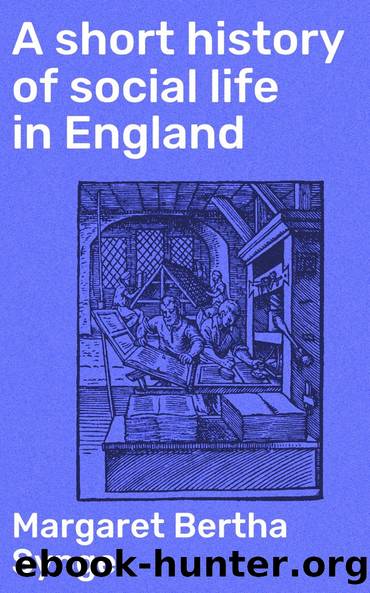A short history of social life in England by Margaret Bertha Synge

Author:Margaret Bertha Synge [Synge, Margaret Bertha]
Language: eng
Format: epub
ISBN: 9781504279390
Google: R77JrQEACAAJ
Publisher: Repressed Publishing LLC
Published: 2014-12-14T01:01:48+00:00
CHAPTER XVI
Table of Contents
Circa 1642â1660
ENGLAND A COMMONWEALTH
"For the apparel oft proclaims the man."âShakspere.
IF a large number of Puritans had sailed away from England to make new homes in America, yet a vast and ever increasing number remained at home. And these, growing stronger and stronger, influenced to no small extent the manners and customs of their country. Dress became a matter, not of fashion, but of conscience, and we get at this period two distinct types existing side by sideâthe Puritan in his sombre and plainly cut garments, the Cavalier in the glory of his slashed silk doublet, his point-lace collar, and his broad-brimmed, plumed hat. To the Puritan, "beauty was a curse and luxury a crime." He turned in disgust from the extravagance of the Court, he held aloof from those amusements and pursuits which he felt were dragging his country to ruin. He cut his hair close round his head, thus earning the nickname of Roundhead as opposed to the long-haired Cavalier, for long hair was to him a luxury and a temptation to vanity. He disliked the soft brimmed hat of the Cavalier, with its graceful ease, wearing instead a stiff, high-crowned, broad-brimmed hat at once severe and forbidding. His doublet and hose were of dark coarse cloth, and his stockings of thick worsted. He wore no bright colours, no lace, no jewels, no ruff; round his neck was a broad folded band of linen. Here were no slashings, no "rustle of silks, no waving of plumes, no clink of golden spurs."
The Puritan lady dressed likewise in sombre hues. She wore a plain silk gown of grey with a folded white handkerchief, or cape with long close sleeves and a plain hood tied under the chin, or a broad-brimmed felt hat with a high crown. All was neat and plain and picturesque, a contrast to the Court beauty and to her gay courtier in his graceful clothes. His doublet was of silk or satin with loose, slashed sleeves, his wide collar of fine lace high up round the throat and turned over, his shirt of the finest linen, trimmed with lace and richly embroidered, his short trousers finished with fringe below the knee, his boots of Spanish leather with wide ruffs at the top. His hair was long, and usually arranged in thick curls, the forerunner of the periwig. No wonder that contemporaries bemoaned these "thousand fooleries unknowne to our manly forefathers," and that against such effeminacy the Puritans made their stand.
It was not dress alone that determined the ever-widening breach between Roundhead and Cavalier. The Puritans were strong enough in the Parliament of 1642 to interfere with popular sports and pastimes in England. Bear-baiting, cock-fighting, and horse-racing were forbidden, theatres were closed, and acting companies dispersed. "Whereas," ran the proclamation, "public sports do not well agree with public calamities, nor public stage plays with the seasons of humiliationâ⦠it is thought fit that while these sad causesâ⦠do continue, public plays shall cease." Sunday was very
Download
This site does not store any files on its server. We only index and link to content provided by other sites. Please contact the content providers to delete copyright contents if any and email us, we'll remove relevant links or contents immediately.
| Africa | Americas |
| Arctic & Antarctica | Asia |
| Australia & Oceania | Europe |
| Middle East | Russia |
| United States | World |
| Ancient Civilizations | Military |
| Historical Study & Educational Resources |
Never by Ken Follett(2880)
The Man Who Died Twice by Richard Osman(2298)
Machine Learning at Scale with H2O by Gregory Keys | David Whiting(2291)
Fairy Tale by Stephen King(2069)
Will by Will Smith(2041)
Rationality by Steven Pinker(1765)
The Dawn of Everything: A New History of Humanity by David Graeber & David Wengrow(1570)
The Dark Hours by Michael Connelly(1570)
Principles for Dealing With the Changing World Order: Why Nations Succeed and Fail by Ray Dalio(1373)
Friends, Lovers, and the Big Terrible Thing by Matthew Perry(1327)
A Short History of War by Jeremy Black(1300)
HBR's 10 Must Reads 2022 by Harvard Business Review(1256)
Go Tell the Bees That I Am Gone by Diana Gabaldon(1234)
Can't Hurt Me: Master Your Mind and Defy the Odds - Clean Edition by David Goggins(1227)
515945210 by Unknown(1207)
Fear No Evil by James Patterson(1109)
443319537 by Unknown(1072)
Works by Richard Wright(1018)
Going There by Katie Couric(991)
